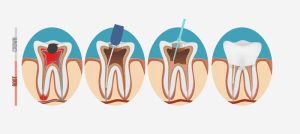What Is a Root Canal (And How Does It Work)?
21 Oct 2016
“Root canal” refers to a cavity in the root of a tooth, containing dental pulp. Dental pulp consists of connective tissue, blood vessels, and nerve fibers, which provide support, nutrition, and sensation to the tooth. The pulp is necessary when a tooth is developing because it provides essential nutrition. However, after full development, the pulp’s nutritional purposes cease to be significant. When it comes to sensation, you can live without feeling in your teeth.
“If the nerve tissue or pulp is damaged, the center of your tooth begins to break down and decay, inviting bacteria to multiply within your tooth and cause an infection.” When the pulp becomes infected and/or inflamed, a root canal treatment is required. This procedure is among one of the most feared dental procedures because of its perceived pain. A number of factors lead to infection in the root canal. In essence, what is really infected is the living tissue within the root canal.
Causes of Root Canal Damage and Necessity of Treatment:
- Inflammation, which in most cases, is caused by bacteria and other harmful microbes
- A problem with drainage that leads to the carrying of substances towards the root. In most cases, this is due to a hole in the tooth causing drainage into the canal and toward the root and gums
- Structural damage at the root resulting from bone loss
- Deep tooth decay
- Direct trauma to the tooth resulting in injury to the pulp
In all these instances, it is unavoidable that the damaged pulp is removed and the root canal cleaned in what is known as the endodontic procedure. This helps avoid further damage to the pulp and gums as well as to ease pain and discomfort.

Overview of the Endodontic Procedure
The procedure starts with an examination to confirm that there is indeed a problem with the root canal.”The dentist will first examine the extent of the decay in your tooth. If any decay has reached the inner layer of your tooth, you will need a root canal.” After confirmation, a doctor administers local anesthetic and a dental dam is placed. The dam keeps the tooth dry from saliva. An opening is then made inside the crown and the pulp is cleaned out of the root canal. In the process, the canal is also shaped. The open space is filled either temporarily or permanently depending on the situation. All of this makes up your first visit, and during your second appointment the crown is restored.
For the most part, this procedure is not painful. Any subsequent discomfort and tooth sensitivity following the procedure is mitigated with prescription medication. If you are still experiencing severe pain after a week, you should go back to the dentist for a checkup.
We are happy to talk you through this procedure to calm any fears you may have. Call (281) 823-9987 to schedule an appointment!
Related Blog Articles